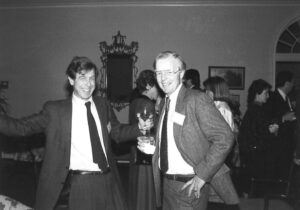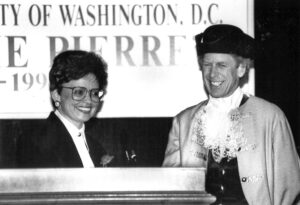Don Alexander Hawkins, architect, city planner, historical cartographer, historic preservationist, trombone player, and decades-long participant in the DC History Center, died on October 5, 2023, at his home in Hillsboro, VA. At his side was his wife Cynthia L. Elliott Hawkins. He was 86.
As a respected architect and urban planner since 1969, Mr. Hawkins leaves a legacy of original discoveries in DC history, especially fundamental aspects of the city’s historical topography and the original L’Enfant Plan.
Some historians are visionaries. Don Hawkins was an en-visionary historian, a creative thinker who looked at the city today and asked, “What was it like before?” Then he proceeded to deeply research the records, maps, paintings, deeds, and correspondence to answer that question.
Don Alexander Hawkins was born on April 24, 1937, in Wheeling, WV, the third child of Adelaide Mulheran Hawkins and Edward Joseph Hawkins. He grew up in Arlington, VA, and graduated from Wakefield High School. He studied architecture and urban design at Catholic University, the Architectural Association (London), and Carnegie Tech, and apprenticed with Hugh Newell Jacobsen. At Carnegie Tech he met and married Ann Walczak in 1961. The marriage, which yielded children Eli and Sarah, ended in divorce. After Cynthia Elliott joined his firm, the two married in 1996.

In 1971 he established Don Hawkins and Associates, offering award-winning architectural and urban design services to the DC metropolitan area. Mr. Hawkins became known as a master of the contextualist approach to architecture, designing structures and renovations that suited their surroundings. He loved wood and stone and “letting materials be what they are,” noted Cynthia Elliott Hawkins.
In 1977 Mr. Hawkins began his systematic study of DC’s topography at the time of its founding. “It wasn’t figuring out L’Enfant’s layout that I first had in mind,” he explained to George Mason University historian Scott W. Berg, “figuring out his thinking and how he was reacting to the geography. I was more interested in his design independent of the topography. But eventually, I realized that it makes a huge difference. What he saw when he got here makes all the difference in the world.” The topographic maps he drew reconstructed the now heavily modified landscape on which Peter C. L’Enfant laid out the city in 1791. (Historians now acknowledge that L’Enfant changed his name to “Peter” in America.) His maps and drawings became indispensable sources for scholars and city planners. His contributions to Washington History magazine include the ground-breaking “The City of Washington in 1800: A New Map” and “The Landscape of the Federal City: A 1792 Walking Tour.” His topographic map of Washington in 1791 was collected by the Library of Congress. He curated “Washington: Symbol and City” at the National Building Museum.
Mr. Hawkins spent years reconstructing William Thornton’s lost original design of the Capitol. And because of his architectural skill, and armed only with images of the exterior, he was able to reconstruct the interior of Federal Hall, the building on Wall Street in Manhattan that L’Enfant redesigned for the First Federal Congress. (It was there that Congress chose the Potomac River for the location of the federal government.)
In 1993 Mr. Hawkins began “Unbuilt Washington,” a series of essays for Washington History on designs for public buildings that were never actually constructed. The first installment, “Unbuilt Washington: The City as It Might Have Been,” set the style and tone for understanding why two elevated express lanes planned in 1945 flanking the National Mall never saw the light of day. The road would have tunneled under and around the Capitol to emerge on East Capitol Street. Mr. Hawkins was the master of ”provok[ing] us to consider alternative visions for our own sense of place,” as then-Editor Howard Gillette explained. At the same time, he gave readers many “Oh, wow!” moments, as in how the Army Corps of Engineers in 1883 proposed a dam across Rock Creek Valley at Massachusetts Avenue to create a 1,200-acre reservoir, with the lower valley and half of Northwest a new national park. “The city would have been assured plenty of drinking water and recreational opportunities,” Mr. Hawkins wrote, “but the Omni Shoreham Hotel on Calvert Street would now be sitting in the water, Woodley Park would be beachfront property, and the Broadmoor apartments at Porter Street would have a grand view of the expansive lake.”
Scott Berg captured Mr. Hawkins’s charm (and his ancient Jaguar automobile) in ”The Beginning of the Road: High-tech computer wizardry and good old-fashioned historical sleuthing are re-creating the lost world of Washington’s origins,” for the Washington Post Magazine in 2008.

Mr. Hawkins also enjoyed puncturing myths about DC’s past. His 2009 review of works on Masonic influences in DC debunked the idea (famously promoted by novelist Dan Brown in The Da Vinci Code) that Freemasons had conspired to embed their symbols and relics in the city, among other popular conspiracy theories.
A number of publications showcased Mr. Hawkins’s work on the L’Enfant Plan, the U.S. Capitol, local Revolutionary War history, and maps of the Potomac and various DC historic districts. In 2018 he contributed a set of new “Maps of the Early District of Columbia,” showcasing his later research, to Creating Capitol Hill: Place, Proprietors, and People by Charles Carroll Carter, William C. DiGiacomantonio, and Pamela Scott, published by the U.S. Capitol Historical Society. He was especially proud of his mother, Adelaide, and her adventures at the birth of the OSS and later the CIA. His story of her career became “Better than Crossword Puzzles,” a chapter in Pauline E. Parker’s Women of the Homefront: World War II Recollections of 55 Americans.
Mr. Hawkins led a student team in developing a master plan for the neighborhood around the Ballston Metro station. Arlington County adopted the plan, and it has guided development there ever since. A collaboration with UMBC’s Imaging Research Center in 2008 produced the animated “A Digital Reconstruction of the Capital, ca. 1814.” And as an outspoken preservationist, Mr. Hawkins worked successfully to stop the National Park Service from cutting a new entrance in the basement of the Washington Monument.
Mr. Hawkins was an entertaining speaker in university and public forums, occasionally portraying L’Enfant in costume. Mr. Hawkins chaired the Parks and History Association from 1999 to 2001 and the Committee of 100 on the Federal City (2006-2008). He was also an accomplished trombonist. He was a member of the Latrobe Chapter, the Society of Architectural Historians; the American Institute of Architects; the L’Enfant Forum; the Cosmos Club, and the DC Preservation League.
Mr. Hawkins was also a great and good friend to the Historical Society of Washington, D.C. (now DC History Center). He served as a trustee and a member of the Editorial Board.
Mr. Hawkins leaves a large community of friends and admirers. In addition to his wife Cindy, he is survived by Eli Hawkins and Sarah Hawkins (husband Jon Bolduc), and granddaughter Lucy Hawkins Bolduc. His family requests that gifts honoring his memory be directed to the DC History Center.